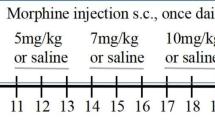Abstract
Rationale
Developmental lead exposure has been found to produce differential patterns of drug self-administration in adult animals.
Objectives
The present study examined the effects of perinatal (gestation/lactation) lead exposure on adult patterns of heroin self-administration.
Methods
Female rats were gavaged daily with 0 mg or 16 mg lead for 30 days prior to breeding with non-exposed males. Metal administration continued through pregnancy and lactation and was discontinued at weaning [postnatal day 21 (PND 21)]. Animals born to control or lead-exposed dams received indwelling jugular catheters as adults and were randomly assigned to one of two studies. In experiment 1, animals were tested on a FR-2 schedule in an effort to examine differential sensitivity to heroin in an intravenous self-administration paradigm. Seven doses of heroin were selected ranging from 0.56 μg/kg to 36 μg/kg per infusion. In experiment 2, littermates were tested on a progressive ratio (PR) schedule in order to more explicitly determine the nature of the change in sensitivity to the drug.
Results
In experiment 1, lead-exposed animals responded for heroin at significantly lower rates across most doses as evidenced by a downward shift in the inverted-U dose–effect curve. Congruent with these findings, lead-exposed animals in experiment 2 exhibited a decrease in progressive ratio responding (lower breaking points) across all heroin doses, further suggesting that perinatal lead exposure attenuates opiate self-administration in adult animals by altering the rewarding efficacy of the drug. In experiment 2, it was determined further that lead-exposed animals had lower latencies to make the initial lever press for heroin.
Conclusions
These results support previous literature suggesting that perinatal exposure to inorganic lead attenuates the effectiveness of opiates as a reinforcer when animals are tested in the adult life cycle.



Similar content being viewed by others
References
Brody DJ, Pirkle JL, Kramer RA, Flegal KM, Matte TD, Gunter EW, Paschal DC (1994) Blood lead levels in the US population: phase I on the third National Health and Nutrition Examination Survey (NHANES III, 1988 to 1991). Centers For Disease Control, Atlanta
Caine SB, Koob GF (1994) Effects of dopamine D-1 and D-2 antagonists on cocaine self-administration under different schedules of reinforcement in the rat. J Pharmacol Exp Ther 270:209–270
Caine SB, Negus SS, Mello NK, Bergman J (1999) Effects of dopamine D-1-like and D-2-like agonists in rats that self-administer cocaine. J Pharmacol Exp Ther 291:353–360
Caine SB, Negus SS, Mello NK (2000) Effects of dopamine D-1-like and D-2-like agonists on cocaine self-administration in rhesus monkeys: rapid assessment of cocaine dose-effect functions. Psychopharmacology 148:41–51
Canfield RL, Henderson CR, Cory-Slechta DA, Cox C, Jusko TA, Lanphear BP (2003) Intellectual impairment in children with blood lead concentrations below 10 μg per deciliter. N Engl J Med 348:517–526
Dearth RK, Hiney JK, Srivasta VK, Burdick SB, Bratton GR, Dees WL (2003) Effects of lead (Pb) exposure during gestation and lactation on female pubertal development in the rat. Reprod Toxicol 16:343–352
Duvauchelle CL, Sapoznik T, Kornetsky C (1998) The synergistic effects of combining cocaine and heroin (“speedball”) using a progressive-ratio schedule of drug reinforcement. Pharmacol Biochem Behav 61:297–302
Ensminger ME, Anthony JC, McCord J (1997) The inner city and drug use: initial findings from an epidemiological study. Drug Alcohol Depend 48:175–184
Holson RR, Pearce B (1992) Principles and pitfalls in the analysis of prenatal treatment effects in mulitparous species. Neurotoxicol Teratol 14:221–228
Hubner CB, Koob GF (1990) The ventral pallidum plays a role in mediating cocaine and heroin self-administration in the rat. Brain Res 508:20–29
Lynch WJ, Roth ME, Carroll ME (2002) Biological basis of sex differences in drug abuse: preclinical and clinical studies. Psychopharmacology 164:121–137
Miller DK, Nation JR, Bratton GR (2000) Perinatal exposure to lead attenuates the conditioned reinforcing properties of cocaine in male rats. Pharmacol Biochem Behav 67:111–119
Miller DK, Nation JR, Bratton GR (2001) The effects of perinatal lead exposure to lead on the discriminative properties of cocaine and related drugs. Psychopharmacology 158:165–174
Nation JR, Cardon AL, Heard HM, Valles R, Bratton GR (2003a) Perinatal lead exposure and relapse to drug-seeking behavior in the rat: a cocaine reinstatement study. Psychopharmacology 168:236–243
Nation JR, Smith KR, Bratton GR (2003b) Developmental lead exposure increases cocaine reward. Pharmacol Biochem Behav 77:127–135
National Research Council (1996) Guide for the care and use of laboratory animals. National Academy Press, Washington
Pirkle JL, Kaufman RB, Brody DJ, Hickman T, Gunter EW, Paschal DC (1998) Exposure of the US population to lead, 1991–1994. Environ Health Perspect 106:745–750
Post RM, Lockfield A, Squillace KM, Contel NR (1981) Drug-environment interaction: context dependency of cocaine-induced behavioral sensitization. Life Sci 28:755–760
Ranaldi R, Munn E (1998) Polydrug self-administration in rats: cocaine–heroin is more rewarding than cocaine alone. Neuroreport 9:2463–2466
Ranaldi R, Wise RA (2000) Intravenous self-administration of methamphetamine–heroin (speedball) combinations under a progressive-ratio schedule of reinforcement in rats. Neuroreport 11:2621–2623
Richardson NR, Roberts DCS (1996) Progressive ratio schedules in drug self-administration studies in rats: a method to evaluate reinforcing efficacy. J Neurosci Methods 66:1–11
Roberts DCS, Benett SAL (1993) Heroin self-administration in rats under a progressive ratio schedule of reinforcement. Psychopharmacology 111:215–218
Rowlett JK (2000) A labor–supply analysis of cocaine self-administration under progressive-ratio schedules: antecedents, methodologies, and perspectives. Psychopharmacology 153:1–16
Valles R, Cardon AL, Heard HM, Bratton GR, Nation JR (2003) Morphine conditioned place preference is attenuated by perinatal lead exposure. Pharmacol Biochem Behav 75:295–300
Acknowledgements
This research was supported by Public Health Service Grants DA13188 and MH65728. We would like to express our gratitude to Carol McNamara, Anna Diller, Avanthi Tayi, and Clint Tippett for their expert technical assistance in the conduct of the investigation.
Author information
Authors and Affiliations
Corresponding author
Rights and permissions
About this article
Cite this article
Rocha, A., Valles, R., Cardon, A.L. et al. Self-administration of heroin in rats: effects of low-level lead exposure during gestation and lactation. Psychopharmacology 174, 203–210 (2004). https://doi.org/10.1007/s00213-003-1742-1
Received:
Accepted:
Published:
Issue Date:
DOI: https://doi.org/10.1007/s00213-003-1742-1




